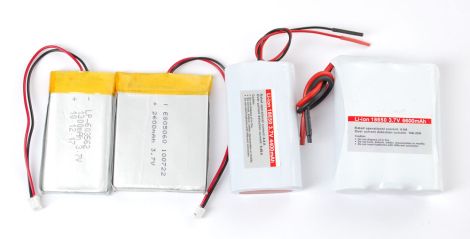
So, you’ve got your awesome project built and are ready to take it on the go, but how are you going to power it? You could use a couple alkaline cells or perhaps swipe a Litihium battery pack from some infrequently used portable device – however before you do that, why not check out what [Lady Ada] has to say on the subject?
The detailed tutorial on her site discusses the different types of Lithium-based batteries and their form factors, as well as the strengths and weaknesses of each type. Voltage ratings are covered, as well as why it is important to choose a Lithium battery pack that fits the task at hand. The dangers of improperly handling batteries are clearly noted, highlighting the importance of selecting a proper charger and resisting the urge to ever wire Lithium batteries together to increase capacity.
While the bulk of the information presented is nothing new to most of our readers, it’s definitely a worthwhile read for those just starting to use Lithium battery technology in their projects.
















Hmm… Strange. They tell not to connect the LiIons in parallel… Well, that’s pretty fine if you charge each one separately beforehand… And if these are all the same exact battery. At least that worked for me with no explosions.
Good stuff, it’s very detailed.
“The answer is that these batteries are assembled by a company that is experienced and certified to test and assemble battery packs. The individual batteries are tested and sorted by machine so that each pack has matching batteries with the same capacity and internal resistance. Individuals do not have this equipment, which is why you should not try to make your own packs. ”
Oh good god. If you want to be a fraidy cat, feel free to follow their advice. Myself on the other hand have rebuilt several hundred battery packs and di exactly this without a problem. they do NOT specially test each battery to make sure they are balanced… they mass assemble by randomly picking cells to make the battery.
I think they decided to scare the newbies a bit so they don’t get careless with lithium cells.
Li cells in parallel inherently self balance.
fartface has it right. they do not specifically test and sort cells since new cells right from the manufacturer all have pretty much the same specs and charge levels. making packs out of new cells from a single batch from one manufacturer is standard and just about as safe as any battery pack.
mixing different capacities/chemistries/ages of cells in parallel is slightly risky since one may reach the end of its life sooner and start self-discharging the cells in parallel with it.
But
never EVER put different capacities/chemistries/ages/manufacturers of cells in series. that’s just a recipe for trouble
Agree with fartface and jerm1386… You do need to be cautious with Li batteries, but come on. If people are to be designing their own electronics they should at least be comfortable working with batteries. You can absolutely parallelize Li-pos. Also, you can serialize them as long as they’re exactly the same cell type (i.e. make and model) and capacity. Just balance them. Cell balancers are not expensive or complicated.
They sell knock-off nokia batteries here in CDRKING for about $2. Anyone know of a good way to connect to these batts? Is the only way to solder wires into the slots?
For future put the youtube video first and a warning “If you are not careful, this will happen. We assume no liability.” — Then get to the information. The incessant warnings were distracting to say the least.
Besides being beaten over the head with “DO NOT DO THIS YOU WILL EXPLODE”, the information was pretty good. I would have enjoyed more in-depth information, but I guess it’s beyond the scope of the writeup.
@ Stevie: You can pry off the top plastic tab and have direct access to the protection circuit PCB, that way you can achieve much sturdier soldering than simply soldering wires to the slots.
The disclaimers were pretty hilarious i think. Don’t put batteries in parallel… BS. Don’t charge batteries in series… That one is actually a valid warning, because the battery that is slightly weaker will start deteriorating fast, and it’ll drastically reduce the capacity of the entire pack after just a hundred cycles or so. But there’s nothing inherently unsafe in it when each battery has its own monitoring and protection circuit.
Both “rules” are violated in every laptop battery pack. They always consist of multiple cells in parallel then series to achieve the required voltage and watt/hour rating. They are monitored individually so if one cell goes weak the whole pack gets shut down, but they are always charged in series with no balancing method employed. That’s why they age so quickly – planned obsolescence.